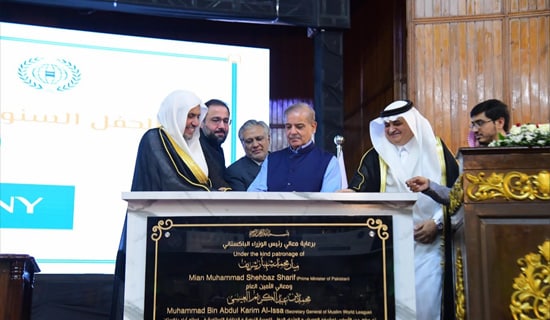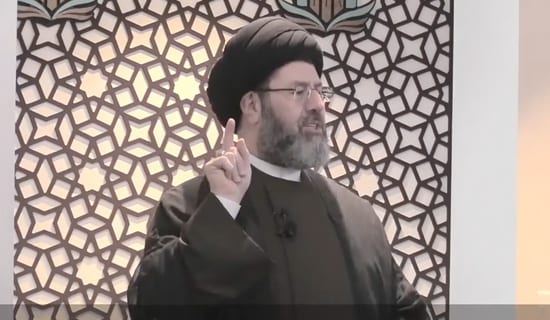Introduction
The first part of this report on the struggle over the hijab in Iran focused on enforcement of hijab on women in public, the Islamic regime's perception of this enforcement, and senior Iranian officials' explanations and justification for it.[1]
This second part will review how the government, headed by President Ebrahim Raisi, is enforcing this policy in recent months, closing public spaces to women who are considered to be wearing their hijab improperly. It will also discuss the position of reformists in Iran in this matter – some of whom are critical of the need for the hijab at all, and others who object to the rigorous and often brutal enforcement of hijab wear. Some also criticized the regime's claim that the hijab directive, and thus its enforcement as well, are Quran-based.
Also in the report are illustrations from a series on "Headgear Do's and Don't's" by Sajjad Jafari, a cartoonist identified with the ideological camp in Iran.
Enforcing The Hijab: Closing The Public Space To Bareheaded Or Improperly Covered Women
The Iranian government's rollout in the past few months of significant crackdowns on women with "improperly" covered hair in public spaces is a manifestation of the ideological underpinning of the regime. Beyond the morality police that operates among women in public – sometimes aggressively and sometimes "by pleasant means" – the regime's ironfisted enforcement of the hijab in public is evident in the closure of public services to bareheaded or improperly covered women: on public transportation, in public institutions, banks, retail establishments, and tourist sites, as well as on billboards and online. The following are some examples:
Fars Province Governor Mohammad-Hadi Imanieh: "Retail Establishments Where Saleswomen [Remove] Their Hijab And Expose [Their Hair] Will Be Closed Until The End Of Summer... If They Continue To Resist [Wearing The Hijab, This] Will Be Dealt With Forcibly"
On July 24, 2022, the Didban Iran website reported on threats by Fars Province Governor Mohammad-Hadi Imanieh to close down retail establishments where modesty laws are not observed and to use force where necessary to implement them: "No one is looking to do anything to spite anyone or to harm [public] sentiment by this means. Everyone is [only] seeking improvement. Even the shutting down of some places is according to the [Fars Province General] Council [for Culture]. If a saleswoman [removes] her hijab and exposes [her hair], that place [where she works] will be closed until the end of summer. This is the decision of the General Council for Culture, but the reason for resistance and arrests must also be clear... If a woman expresses regret when reminded to take care with her hijab, she will be dealt with leniently. But if she continues to resist [wearing it, the matter] will be handled forcibly."[2]
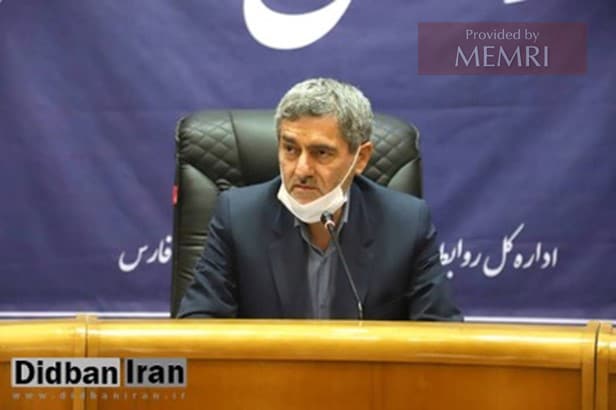
Fars Province governor Mohammad-Hadi Imanieh (Source: Didban Iran, Iran, July 27, 2022)
Bushehr Governor Salah Rahimi: "Women And Men Must Have Separate Rooms In Offices"; I'll Fire Any "Manager Who Disregards" Enforcement Of The Full Chador In The Municipality Office
Salah Rahimi, governor of the city of Bushehr, said on July 5: "Women and men must have separate rooms in all government institutions, and no woman should be present in the Bushehr city council office without a chador [full-body covering]. I will fire any manager who disregards this."[3]
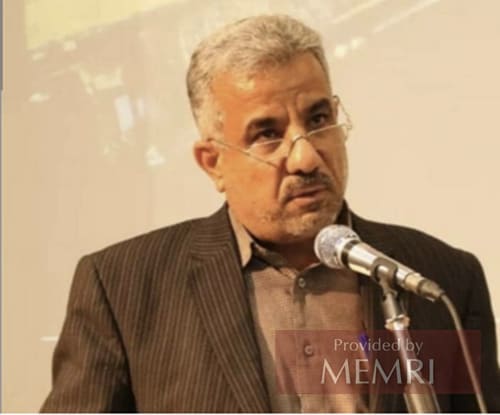
Bushehr governor Salah Rahimi (Khabaronline, July 5, 2022)
Mashhad City Prosecutor Asks Mashhad Governor To Prevent Bareheaded Women From Entering Subway
In a letter published online on July 5, the Mashhad city prosecutor asked the city governor to prevent women with their hair only partially covered from entering the subway. He noted in the letter that the authority to stop women without a proper hijab from using the subway had been given to the mayor, that the police commissioner had announced his "willingness to deal with [these] criminals," and that "if the police disregard [this matter], which will lead to acceptance of this crime and promotion of vulgarity, it will be [a situation of neglect] that will be subject to prosecution according to Section 576 of the Islamic punitive law."[4]
Bank Mellat Bans Sheer Stockings, Heels, And Makeup For Women Employees
The Didban Iran website reported that on July 5 one of Iran's biggest banks, Bank Mellat, had announced a dress code for female employees and managers' secretaries: no sheer stockings, no high heels, and no makeup.[5]
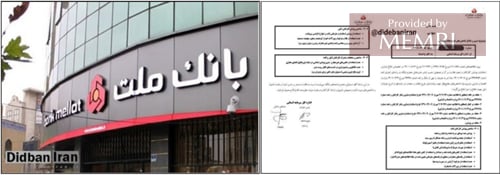
Bank Mellat's announcement (Didban Iran, Iran, July 5, 2022)
Radio Farda Report: Ministry Of Islamic Guidance Announced That Women May Not Appear In Any Iranian Advertisement In The Public Space – i.e. Billboards – Or Online
The Radio Farda website reported on July 23, 2022: "In a letter to private art and film schools in Iran, the Ministry of Islamic Guidance and Culture announced that from now on, in accordance with the [Ministry's] hijab and modesty decisions, no women may appear in advertisements. According to the letter, which was sent July 20, 2022 and signed by the head of the General Division of Guidance in Alborz Province, advertising agencies may no longer feature women in ads...
"This directive was published after the circulation in recent weeks of a promotion for an ice cream company provoked reactions. The Headquarters for Enjoining Good and Forbidding Evil declared this a crime, condemned the use of an actress in the advertisement, which was by the Domino agency, and stated that producing such ads 'promotes immodesty' in society..."[6]

The ad in question (Source: Radiofarda.com, July 23, 2022)
Reza Ayaz, Head Of Saveh City's Cultural Heritage, Tourism, And Handicrafts Department, Threatens To Close Tourist Sites: "We Are Making Efforts To Prevent Female Citizens With No Or Partial Hijab From Entering Tourist Attractions In Saveh"
In a July 4, 2022 interview with the official news agency IRNA, Reza Ayaz, head of the Cultural Heritage, Tourism, And Handicrafts Department of the city of Saveh, said: "One of the central plans of the cultural heritage department is setting moral and Islamic values, such as the Islamic hijab, at tourist sites of the city of Saveh. For this reason, we have decided to place this important matter on the [department's] agenda, for our visitors' convenience.
"We are making efforts to prevent female citizens with no or partial hijab from entering tourist attractions in Saveh. The first warning [to a woman] in this matter will be verbal. If the hijab issue is not honored by the tourists and visitors to the city's tourist attractions, these places will be closed for the remainder of the week..."[7]

Bans on colorful hijabs, sheer stockings, and makeup. Bonyana.com, Iran, November 18, 2018.
Yasuj Province Prosecutor-General Ali Malek Hosseini: 29 Women's Hairdressing Salons In Yasuj Have Been Shut Down
The Asr-e Iran website reported on July 16, 2022 that according to Ali Malek Hosseini, prosecutor general of Yasuj Province, over two dozen women's hairdressing salons that circulated inappropriate photos and videos online had been shut down: "To date, 29 hairdressers have been identified by the Branch for Oversight of Cyberspace [as violating hijab and modesty standards] and by the office of the prosecutor for organized crime. As part of a comprehensive case, and taking prioritization into account, judicial orders have been issued to stop the activity of these [hairdressing] centers. All these centers have been shut down, through the efforts of the Oversight Of Public Places Police. The owners of these salons will be summoned as accused parties, and the investigation will continue..."[8]
"Love Stations" Established At Tehran Subway Stations
SUPPORT OUR WORK

On July 13, 2022, the Fars news agency reported: "Concurrently with Hijab and Modesty Week and with the aim of promoting this Islamic and Iranian value and providing a practical example of the proper [implementation] of the [Quranic] directive of 'enjoining good and forbidding evil,' the Methl-e Haniyah student organization, with the support of the subway's culture authorities, has erected 'love stations' at five [Tehran] sites – the Sahr Theater [Tehran's performing arts complex with five theaters], Jihad Square, Valiasr Square, Shadman Square, and Imam Khomeini Square."
The Methl-e Haniyah organization is named for Haniyah, the only woman martyred at the Battle of Karbala in 680.
The report continued: "The Mithl-e Haniyah team is at these stations. They distribute cultural gifts, engage in friendly conversation, and invite women who are not wearing the hijab properly to choose one of the martyrs whose portraits and last testaments are displayed at the [love station's] booth to be their divine partner, to serve as a companion and as a model for emulation throughout their lives, and for them to try to be more like them every day. Then, as a first step in trying to be like the martyrs and to ally with them, these women are asked to correct their hijab with lovely barrettes they can have for free, if they wish."

Iranian women at the subway "love stations" encouraging the proper wearing of the hijab
Reformist Public Figures Criticize The Hijab Enforcement
Even before the eruption of the public protests in Tehran following the death of Ms. Amini in morality police custody, there was public criticism of the regime's hijab-enforcement policy, especially from academic and reformist circles. Some of them refuted the claim that the hijab is mandated by the shari'a, while others who may not necessarily oppose the hijab itself were against its aggressive enforcement and the emphasis placed on it at the expense of other, more urgent, issues. The following are several examples of this criticism:
Former Majlis Member Sadeghi: "What Does The Leader [Khamenei] Say About The Treatment Of Ms. Amini At The Hands Of The Iranian Police?"
Following the news of Ms. Amini's death on September 16, legal expert and former Majlis member Mahmoud Sadeghi challenged Khamenei in a tweet, writing: "What does the Leader [Khamenei], who rightly condemned the American police for the death of George Floyd, say about the treatment of Mahsa Amini at the hands of the Iranian police?"[9]

Mahmoud Sadeghi's tweet
Qom Seminary Scholars and Researchers Assembly Member: "What Shari'a And What Law Underpin This Directive [Requiring Women To Wear The Hijab In Public]?"
On July 4, 2022, Mohammad Taqi Fazel Maybodi, a member of the Scholars and Researchers Assembly at the Qom Religious Seminary, criticized the exclusion of women from the public sphere. He tweeted: "The Mashhad deputy city prosecutor declared that 'banks and offices may not serve women who are not wearing a proper hijab.' What shari'a and what law underpin this directive? Is this not heresy? Can a citizen be deprived of her rights because of a hijab? What is the moral value of this hijab? The modesty patrols have become terror patrols. Don't terrorize the citizens in the name of religion."[10]

Mohammad Taqi Fazel Maybodi's tweet
Senior Reformist Journalist And Political Activist Abbas Abdi: Denying Services To Bareheaded Women Is "A Catastrophe"
On July 4, 2022, Abbas Abdi, senior reformist journalist and political activist, tweeted: "The fact that the [Mashhad city] prosecutor is not aware of the illegality of this directive [to deny service to bareheaded women], or is aware of it and [nevertheless] issued the decree, is a catastrophe. The judiciary and the administrative court must take legal and administrative action against him."[11]

Abadi's tweet
Mohammad Mohajeri, Ideological Camp Media Figure: Instead Of Emphasizing Shari'a, Let's Promote The Hijab As A Social Norm And Hand Enforcement Over To The Citizens Themselves
In a June 5, 2022 op-ed in the Etemad newspaper, Mohammad Mohajeri, a former editor of the regime mouthpiece Kayhan daily, called for reforming the method of promoting hijab wear. Instead of charging the religious and government institutions with enforcement, he suggested a sociocultural process in which citizens will enforce the dress code themselves as a social norm. He wrote:
"The issue of the hijab arose as a challenge in the months following the victory of the [1979 Islamic] Revolution, and the policy in this matter was sometimes strict, sometimes lenient, and sometimes took the form of turning [the restrictions] 'on and off.' The result of all those measures and behaviors is what we are dealing with today. That is, the religious [sector] is displeased with the situation, the opposition seeks to increase its challenge [to the regime], the intellectuals believe it should be left alone, and the government is hesitant about it.
"If the hijab remains an important challenge, and so much energy is devoted to it, what is its benefit to society? Will society become more modest, with more [women wearing] the hijab? This question gains importance because the hijab issue is sometimes sociocultural and sometimes political, and even a security issue – and then ruling regarding it becomes so knotted it cannot be undone.
"Some religious elements push to enforce the hijab at any cost, on the grounds that it is a shari'a law, and think that by doing so they are meeting their shari'a obligations. Don't these people's declarations contradict the fatwas of some ayatollahs who believe that when necessary, it is even permissible to temporarily shut down the religious branches... Whenever the issue of the hijab comes up, some people say that we should first of all stop embezzlement, theft, and the [rising] cost of living! This argument is clearly deficient, but prevalent despite its flaws...
"The evidence indicates that although [fashions in] the mantu [long jacket worn by many Iranian women] and headscarf change daily, the percentage of people who dismantle frameworks and overstep moral boundaries is not very high. This small minority is not accepted even by women who do not wear the hijab. Therefore, instead of emphasizing the shari'a, let us transfer the burden of overseeing hijab [wear] to the citizens, even to the women who do not wear the full hijab. This way, the citizens themselves will gradually come to reject immodest dress, just as smoking in enclosed spaces and reckless driving are considered social transgressions and citizens protest against them in every possible way. The same can happen in the case of the hijab.
"Instilling sociocultural norms takes time... Let's pretend [for a moment] that the revolution triumphed only yesterday and that we are at the beginning of the road. What do we want to do now? The issue of the hijab cannot be dealt with by assuming that 'we are responsible for the task, not for the consequences.' We know from experience that [such an approach] will exacerbate the situation."
"Like many other offenses, such as [drug] addiction, divorce, and so on, the [issue of the] hijab has more than one side, and resolving it cannot be left up to the Headquarters for Enjoining Good and Forbidding Evil or the religious institutions. We must correctly identify the harm caused by neglecting the hijab. In order to obtain this information and then deal with it, we must elicit the views of many people, including of women who wear a partial hijab."[12]
Op-Ed In Tabnak: "What Percentages Of Women Arrested For This Issue [Have Been] Treated Violently, Been Educated, Or Become Modest?"
An op-ed published by the Tabnak website on July 5, 2022, titled "A Peek At The Ways And Methods Of Dealing With Women Who Fail To Wear Full Hijab or Wear None At All," cast doubt on the effectiveness of hijab enforcement as it is currently being carried out, criticizing the methods of intimidation and violence. The following are excerpts:
"There is no doubt that hijab is a divine decree and that it must not be neglected... [There is also no doubt] that just as the problem of citizens' livelihood must be addressed, so must social, belief, cultural, and religious norms, as well as social customs. Perhaps it would be preferable for those who insist [on women's hijab wear] to begin the work [of oversight and enforcement] in government offices, public centers, and community groups, instead of violently dealing with hijab-less [women]. And, instead of patrolling the streets and city squares, the oversight institutions [could] oversee both standards for head covering and behavior resistance as well as the standards of the regulations for government workers – men and women alike – to show whether employees of these institutions provide better service to those with standard head covering [hijab] or not...
"It is sometimes surprising why no attention is paid to implementing the rules and regulations, say, at event halls. Oversight can easily be implemented [by preventing hijab-less women from entering] and [women] who are immodest with regard to their hijab can be dealt with at the same time. But sometimes [hijab-less] pedestrians on the street are dealt with so harshly that even women in hijabs who observe this behavior come to their aid.
"What is this widespread policy that does not insist on a legal fight against corruption but seeks to take dramatic and tension-causing moves? Does this mean that we can say that the relevant officials are not aware of the corruption that creates all kinds of deviations and violations of norms [in Iran] but see only pedestrians who are not wearing the hijab in the street? And, more importantly, what was the outcome of the various plans implemented so far concerning modesty and the hijab? Thus, it appears that there must be a fundamental and fair analysis of this area, and answers to many questions.
"For example, [the oversight institutions must] answer [the question of] whether there has ever been a detailed and scientific discussion with members of the morality police who are on the front of implementing the modesty and hijab plan, in order to ask them about their assessment of these violent operations against women without a hijab. What percentages of women arrested for this issue [have been] treated violently, been educated, or become modest?... Or [to ask these institutions] whether the prosecutor and the governor, who are violating the law by not providing certain social services to women customers without a hijab, ever wondered about the basis of this ban in the law or the sharia, and where exactly it says in the law or the sharia to strip women of their rights?
"But the most important and fundamental thing is, which [women are they who go] without a hijab [or cover their hair only partially]? What criteria are there for [defining] the hijab-less? The women who appear on television only partially covered by the hijab during certain national ceremonies, such as a march for Islamic Revolution Victory Day or Election Day, and whom the media and society consider to be without a hijab – [are they too considered as] fitting into the category of the hijab-less?
"In short, one of the most important traits of every operation carried out in the area of public government is that we must think about the outcome. If we seek to show that we are busy doing something, such operations are definitely helpful. But if we do not see ourselves as carrying out tasks [for their own sake], and we believe that these operations must yield concrete, effective, and ongoing results, the time has come to consider this matter – that the sphere of modesty and the hijab has many faces and economic, cultural, social, and administrative factors that are involved in choosing how to cover up [the faces and bodies] of half the citizens of this country.
"Ultimately, we should remember that wisdom, logic, the shari'a, and justice are conditions [for making and implementing decisions] and that we must not neglect [consideration of] the reasons and factors [for failure to properly wear the hijab] and must focus on those who are harmed in this matter. We must try to be more careful in our decisions in this sensitive situation in the country."[13]

Morality police warn a woman partially wearing the hijab (Source: Tabnak, Iran, July 5, 2022.
Article In The Pragmatic Asr-e Iran: "If [The Morality Police] Have To [Force] Women And Girls... Into Their Vans – How Do You Think They Will Manage, Within [Just] A Few Hours, To Instruct Them And Persuade Them [To Wear The Hijab Properly]?"
The pragmatic Asr-e Iran website published on September 17, 2022 an article titled "The Sad Death of Mahsa Amini And Three Questions For The [Morality] Police." The following are its main points:
"Almost no one is in a good mood after the tragic death of Mahsa Amini. Therefore... this article comprises [only] three short questions for the [morality] police:
"1. When it was reported that Mahsa Amini had been arrested because of what she was wearing, many certainly thought that she had been dressed inappropriately. But when the photos and videos of her came out, we all saw that she had on a long jacket and a large scarf, and that, like most Iranian women and girls, she was dressed absolutely normally and modestly, and it was interesting that she had come with her family to Tehran. Even if you insist on [having] morality police, what was the basis for your police to apprehend and take away a woman dressed so legitimately, [and] for an occurrence that should not have happened? Really, why?
"2. In contrast to people and streams [apparently referring to the pragmatic and reformist streams] who insist that Mahsa Amini had been beaten, we do not accept such a claim without documentation. We eagerly await the official legal medical report, but ask the police to be transparent regarding the video that was released of Mahsa Amini at 'moral security police' headquarters, and to provide answers to doubts such as why this video begins in daylight and then cuts to night.
"3. All girls in Iran grow up in the educational system for at least 12 years. Even the radio and official publication institutions produce a constant stream of 'guidance' for society, 12 months a year. If Iranian women and girls are not guided as the authorities [wish], despite all these efforts [to safeguard modesty], and must be forced into the vans [of the morality police], how do you think they will manage, within [just] a few hours, to instruct them and persuade them [to wear the hijab properly]? What marvelous psychological method do you use to really guide women and girls, who have not been guided all their lives in the proper path? If you have such magic, grant it to the educational, cultural, and propaganda institutions. And if you do not [have this], and you yourselves know that you are doing an expensive and useless thing, [then] stop it [for the sake of] the worthy honor of the real name of the [morality] police and their uniforms, and devote all your might to their main missions, among which are the good of this world and the next."[14]

Photos of Mahsa Amini at "Morality Security Police" headquarters (Source: Asr-e Iran, September 17, 2022)
*A. Savyon is Director of the MEMRI Iran Media Project.
[1] MEMRI Special Dispatch No. 10241, Iran's Hijab War – An Expression Of The Struggle For Political Freedom: Part I, October 3, 2022.
[2] Didbaniran.ir/fa/tiny/news-136519, July 27, 2022.
[3] Khabaronline.ir/news, July 5, 2022.
[4] Khabaronline.ir/news, July 5, 2022.
[5] Didbaniran.ir/fa/tiny/news-136519, July 5, 2022.
[6] Radiofarda.com, July 23, 2022.
[7] IRNA.ir, July 4, 2022.
[8] Asriran.com, July 16, 2022.
[9] Twitter.com/mah_sadeghi, September 16, 2022.
[10] Twitter.com.fazelmaybodi, July 4, 2022.
[11] Twitter.com/abb_abdi, July 4, 2022.
[12] Etemad (Iran), July 5, 2022.
[13] Tabnak.ir, July 5, 2022.
[14] Asriran.com, September 17, 2022.



